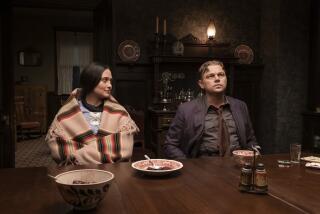‘Man on Fire’ has a split persona
Two for the price of one is not always the deal we want it to be. “Man on Fire” plays like a pair of completely different films, and the one we’ve been expecting turns out to be weaker than the one that comes as a surprise.
What we’ve been expecting is what we’ve been taught to anticipate from Tony Scott, a director known to showcase lots of things blowing up and lots of people being blown away.
Scott was one of the first filmmakers to make the transition from commercials to features, and the visual component is always a key focus of his work. But when he’s had interesting material to work with, as he did in “Enemy of the State” and “Crimson Tide,” he’s made good use of it, and he has a similar opportunity here.
Working from a script by the expert Brian Helgeland (“L.A. Confidential,” “Mystic River”) and based loosely on an A.J. Quinnell novel about a burned-out bodyguard and the little girl he is hired to protect, Scott has turned out a film that is, unlikely as it sounds, initially more a character study than anything else.
“Man on Fire” stars Denzel Washington, which is always a good place to start if you want to be taken seriously. One of those actors who might not be able to give a bad performance on a bet, Washington elevates whatever he’s in, bringing great layers of conviction and plausibility to genre material.
He plays John “Crease” Creasy, a seen-too-much drinks-too-much veteran of counterterrorism actions so horrific that when Crease asks best pal Rayburn (Christopher Walken), “You think God will forgive us for what we’ve done?” the answer is a laconic “No.”
Rayburn, however, is in better shape than his Jack-Daniels-Is-My-Copilot buddy. He’s become rich in Mexico and suggests that the unemployed Crease use his expertise to cash in on the need for bodyguards in that kidnapping-crazed country. Which is how Crease comes to be hired by American Lisa Ramos (Radha Mitchell) and her Mexican husband, Samuel (Marc Anthony), to watch over their 9-year-old daughter, Pita.
Not only does this sound like a shameless emotional set-up, it is a shameless emotional set-up, but it is also surprisingly effective. Credit is due Scott, Helgeland and the completely involving acting of Washington and young Dakota Fanning, who, despite her age, has so much force and presence she actually holds her own on screen against her always powerful costar.
An exceptionally gifted young person who’s been in several films, including “Uptown Girls” and “I Am Sam,” Dakota probably hasn’t seen enough movies to know how easily her part could have fallen into cliche. Instead she turns Pita into a delightful, distinctive, self-possessed individual, likely the most mature youthful presence we’ll see on screen all summer.
Conscious of what it has, “Man on Fire” gives considerable time, close to an hour, to the development of this relationship. It’s so satisfying that we don’t even mind that the bodies we know will be falling have had to wait in the wings while Crease and Pita get to know each other.
But then, like fairy tale ogres who’ve slept too long, the more conventional aspects of “Man on Fire” rouse themselves and get into gear. Pita gets placed in jeopardy and Crease, not a happy camper, goes into what can judiciously be described as a murderous rage.
Though he has taken on dark-side characters before, most notably in “Training Day,” it’s not exactly standard for individuals Washington plays to be seen cutting off people’s fingers, one by one. The idea behind the extended getting-to-know-you section likely was to provide sufficient motivation for the savagery and the rage, to help us understand why friend Rayburn portentously says of him, “His art is death. And he’s about to paint his masterpiece.”
That blueprint is only partially successful. Though the character half of “Man on Fire” functions as planned, it can’t remove either the heedless implausibility or the savagery of the second. Watching Crease go on one of those movie vengeance rampages that have become so standard in current films makes you wonder exactly what American audiences, likely the world’s most affluent and powerful, have to be so angry about.
Despite its high craft level and Washington’s participation in it, this movie’s showy violence is finally as deadening as the over-emphatic violence in these kinds of films generally is. It’s a shame that people who enjoy the first half of “Man on Fire” will have as little use for the second as those who like the second will have for what came before.
*
‘Man on Fire’
*
MPAA rating: R for language and strong violence
Times guidelines: Fingers are cut off one by one; other moments of extreme violence.
Denzel Washington...Creasy
Dakota Fanning...Pita
Christopher Walken...Rayburn
Giancarlo Giannini...Manzano
Radha Mitchell...Lisa
Marc Anthony...Samuel
Rachel Ticotin...Mariana
Mickey Rourke...Jordan
Fox 2000 Pictures and Regency Enterprises present a New Regency/Scott Free production, released by Twentieth Century Fox. Director Tony Scott. Producers Arnon Milchan, Tony Scott. Executive producers Lance Hool, James W. Skotchdopole. Screenplay by Brian Helgeland, based on the novel by A.J. Quinnell. Cinematographer Paul Cameron. Editor Christian Wagner. Costume designer Louise Frogley. Music Harry Gregson-Williams. Production designers Benjamin Fernandez, Chris Seagers. Art director Hector C. Romero. Running time: 2 hour, 26 minutes.
In general release.
More to Read
Only good movies
Get the Indie Focus newsletter, Mark Olsen's weekly guide to the world of cinema.
You may occasionally receive promotional content from the Los Angeles Times.











